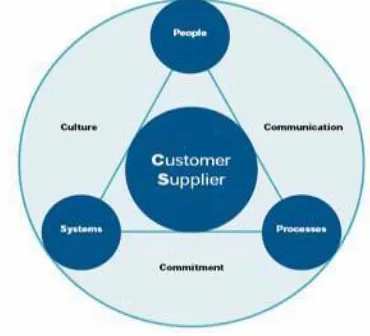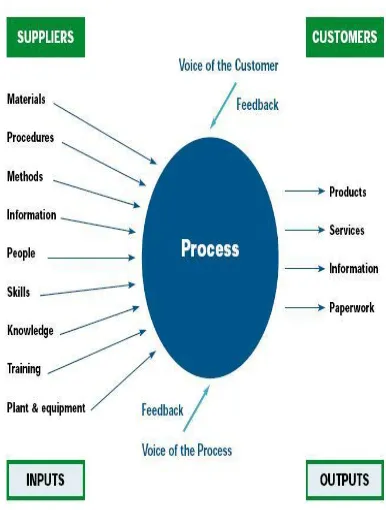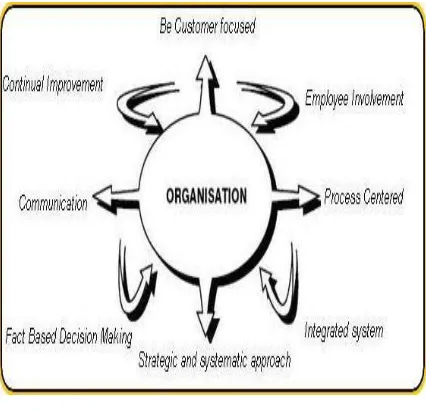Available Online at www.ijpret.com 155
INTERNATIONAL JOURNAL OF PURE AND
APPLIED RESEARCH IN ENGINEERING AND
TECHNOLOGY
A PATH FOR HORIZING YOUR INNOVATIVE WORK
TOTAL QUALITY MANAGEMENT
TAMLOORKAR AVDHUT R., SURYAWANSHI NITIN N. 1. Associate Professor, J. T. Mahajan College of Engineering, Faizpur(M.S.),India
2. Principal, IBSS College of Engineering, Amravati
Accepted Date: 05/03/2015; Published Date: 01/05/2015
\
Abstract: This paper focuses on the crucial aspects of TQM right from introducing concepts in an organization, especially for those who have not traditionally tuned themselves too much with understanding customer needs and business processes. Major focus is on empowerments, as it plays very crucial role to identify the management culture before attempting to install TQM. In recent years the literature on change management and leadership has grown steadily, and applications based on research findings will be more likely to succeed. Visionary leadership may offer an overriding perspective for someone instituting TQM. Use of tested principles will also enable the change agent to avoid reinventing the proverbial wheel. Institutionalizing TQM principles as an organizations culture process for managing the transition from the existing system to the new system with synergies.
Keywords: Proverbial, Fostering, Bandwagon
Corresponding Author: MR. TAMLOORKAR AVDHUT
Access Online On:
www.ijpret.com
How to Cite This Article:
Tamloorkar Avdhut, IJPRET, 2015; Volume 3 (9): 155-161
Available Online at www.ijpret.com 156 INTRODUCTION
TQM is not an easy concept to introduce into the businesses particularly in companies who are not traditionally concerned about themselves too much with understanding customer needs and business processes. One of the main challenges of introducing the TQM concept is to make a significant impact on business, as TQM focuses on the activities that are closest to the customer satisfaction through meeting their requirements. It also provides opportunity for management to focus on an organizational culture during continuous improvement by empowering employees and involving them judiciously.
TQM is an approach to improving the competitiveness, effectiveness and flexibility of an organization for the benefit of all stakeholders, if combined with effective leadership, results in an organization doing the right things at right and first time.
It is a systematic way of planning, organizing and understanding each activity, and removing all the unnecessary efforts and energy that routinely spent in organizations. It ensures the leaders to adopt a strategic overview of quality and focus on prevention not detection of problems. All businesses have many types of customers. A customer can be someone "internal" to the business (e.g. A production employee working at the end of the production line is the "customer" of the employees involved earlier in the production process). The customer can also be "external to the business, this is the kind of customer you will be familiar with.
Available Online at www.ijpret.com 157 The core of TQM is the customer-supplier interfaces (Fig1) both externally and internally, and at each interface lie a number of processes. This code must be surrounded by commitment to quality, communications of the quality messages, and recognition of the needs to change the culture of the organization to create total quality. These are the foundations of TQM, and they are supported by the key management functions of people, processes and systems in the organization. (Fig 2)
Fig 2: TQM Process Management
TQM recognizes that all business required "processes" that enables customer requirements to be met. TQM focuses on the ways in which these processes can be managed - with two key objectives:
1 100% customer satisfaction
2 Zero defects
Gurus:-
Available Online at www.ijpret.com 158 industrial settings; although all claim that their ideas are equally applicable to service industries. None of them, except Peters, has given much consideration to quality issues in education. Nevertheless, their contribution to the quality movements has been so great that it is difficult to explore quality in education without recourses to their thinking.
PRINCIPLES OF TQM:-
Customer focused: Whatever we did for quality improvement, focusing only on customers to improve the level of quality, fostering quality improvement, training employees, integrating quality into process management, as we know that only customers can determine whether our efforts were worthwhile.
Employee Involvement:Through using Deming 8th principal of removal fear from work place, by empowering employee by providing a supportive environment.(See Fig3)
Fig 3: TQM Working Environment
Process Centered: A fundamental part of TQM is to focus on process thinking.
Integrated system: All employees must know the business mission and vision. An integrated business system may be modeled by MBNQA or ISO 9000.
Available Online at www.ijpret.com 159 Continual Improvement: By constantly adopting usage of an analytical, quality tools, and creative thinking to identify critical areas for improvements. Constantly benchmarking performance against latest legal, regulatory and statutory requirements, and taking appropriate actions for getting efficient and effective upgraded results.
Fact Based Decision Making: Decision making only based on data, not personal or situational thinking based on intuition at critical stages that affect the organization's mission, vision, and measurable goals.
Communication: Communication strategy adopted within the working system, it is a method and real time basis take decisions correctly, to maintain transparency in working, and also to aid in building confidence among all staff members.
Tools of TQM:-
Deming cycle/PDCA cycle,
Scatter diagrams, and
Tools to Organize the Data consists of Pareto charts and Flowcharts.
Tools for Identifying Problems consist of Histogram and Statistical process control chart.
Check Sheet is an organized method of recording data.
Scatter Diagram is a graph of the value of one variable vs. another variable.
Cause and Effect Diagram is a tool that identifies process elements (causes) that might affect an outcome.
Flow Charts (Process Diagrams) are a chart that describes the steps in a process.
Cause-and-Effect Diagram
What is a Cause-and-Effect Diagram?
Available Online at www.ijpret.com 160 Why should we use a Cause-and-Effect Diagram?
A Cause-and-Effect Diagram is a tool that is useful for identifying and organizing the known or possible causes of quality, or the lack of it. The structure provided by the diagram helps team members think in a very systematic way. Some of the benefits of constructing a Cause-and Effect Diagram are that it helps to determine the root causes of a problem or quality characteristic using a structured approach.
Encourages group participation and utilizes group knowledge of the process. It uses an orderly, easy-to-read format to diagram cause-and-effect relationships.
It indicates possible causes of variation in a process.Increases knowledge of the process by helping everyone to learn more about the factors at work and how they relate.Identifies areas where data should be collected for further study.
BENEFITS:-
Improved Quality
Employee Participation
Team Work
Internal & External Customer Satisfaction
OBSTACLES:-
Organization Structure & Departments.
Available Online at www.ijpret.com 161 Internal & External Customers-Dissatisfaction
CONCLUSION:-
TQM brings problem solving techniques and continuous improvement opportunities. The effective use of TQM helps companies obtain the maximum return on investment. Total Quality Management is still considered as a long term continuous improvement initiative; still many organizations took courage to jump into the bandwagon with a serious leadership commitment as well as total Employee involvement to drive their business into sustainable profitability, continuous improvement in culture.
REFERANCES:-1. Research paper on Total Quality Management Vol. 21, No. 9, September 2010
2. Ahire, S.L., &Golhar, D.Y. (2001).Quality management in large versus small firms. Journal of Small Business Management, 27, 1–13.


